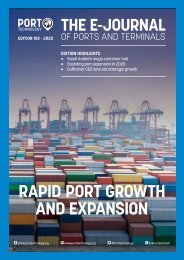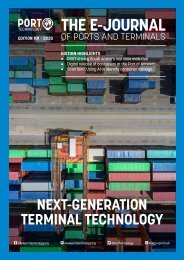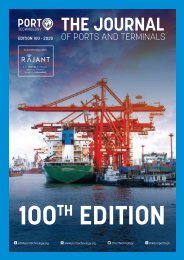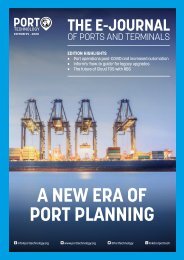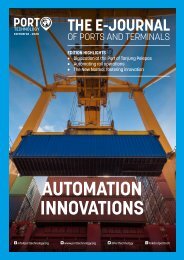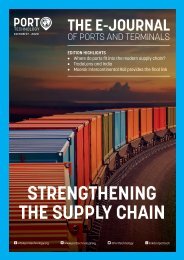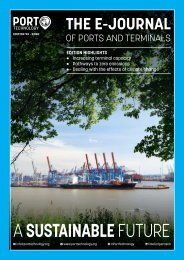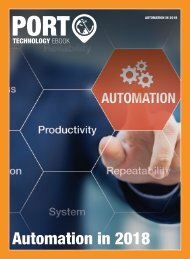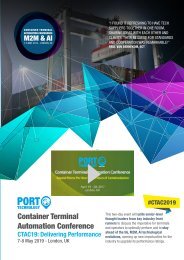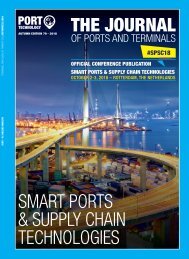Automation's Next Step
This edition of The Journal considers automation of container terminals and how the industry is delivering the next steps towards full and semi-automation. With the inclusion of over 30 technical papers The Journal also explores terminal planning in the age of automation, environmental sustainability for ports, the impact of mega ships and other topics. Automation continues to drive innovation across several industries, and there is no greater example of this than maritime. However, implementation, technology and best practices continue to be a constant source of debate and analysis across the sector, as is shown in this edition of the PTI Journal. The automation debate is not new, but it remains a booming market and a source of growth for the wider container terminal industry. One thing is for certain, automation is here to stay.
This edition of The Journal considers automation of container terminals and how the industry is delivering the next steps towards full and semi-automation.
With the inclusion of over 30 technical papers The Journal also explores terminal planning in the age of automation, environmental sustainability for ports, the impact of mega ships and other topics.
Automation continues to drive innovation across several industries, and there is no greater example of this than maritime.
However, implementation, technology and best practices continue to be a constant source of debate and analysis across the sector, as is shown in this edition of the PTI Journal.
The automation debate is not new, but it remains a booming market and a source of growth for the wider container terminal industry.
One thing is for certain, automation is here to stay.
You also want an ePaper? Increase the reach of your titles
YUMPU automatically turns print PDFs into web optimized ePapers that Google loves.
TERMINAL PLANNING<br />
INCREASING<br />
TERMINAL<br />
CAPACITY BY 10%<br />
A CASE STUDY IN YARD TRANSFORMATION<br />
Björn Henriksson, ABB Ports, Sweden and Lin Hong-Wei<br />
and Wang Hong-Liang, Tianjin Port Container Terminal Co., Ltd<br />
This paper examines the way Tianjin Five<br />
Continents International Container Terminal<br />
Co. Ltd. (FICT) in China resolved the ‘megaage’<br />
yard challenge by modernizing and<br />
automating its existing manual RMGs.<br />
The case study explains the solution<br />
and improvements in KPIs achieved by<br />
improving the efficiency of yard operations.<br />
As discussed in earlier papers written<br />
by ABB, we inhabit the ‘mega-age’ of<br />
megaships and consolidated shipping<br />
lines. It is an era which has forced the<br />
need to re-equip existing terminals and<br />
improve efficiency and productivity into the<br />
spotlight. To avoid becoming a bottleneck,<br />
the yard of today needs to be equipped<br />
with solutions that can support the required<br />
increase in capacity and productivity while<br />
retaining cost-efficient service to both<br />
waterside and landside operations.<br />
ABOUT FICT<br />
FICT, which is part of Tianjin Port Container<br />
Terminal Co., Ltd., is located in the Port of<br />
Tianjin. With 500 international port calls<br />
per month and total yearly volumes of 16<br />
million TEU, Tianjin is the tenth busiest<br />
container port in the world and the largest<br />
in Northern China. The port is also the main<br />
maritime gateway to Beijing and serves as<br />
a link between the Northeast Asia, Central<br />
Asia and the Middle East.<br />
The terminal was built in 2003 and was<br />
originally designed for annual throughput<br />
of 1.5 million TEU, which has become<br />
insufficient in the mega-age. In 2018 the<br />
terminal’s actual volume clearly exceeded<br />
the design capacity and reached 2.57MTEU.<br />
The terminal’s perpendicular yard is<br />
equipped with 31 RMGs which were<br />
originally manually operated. It has capacity<br />
to store containers corresponding 32,000<br />
TEU. The RMGs at FICT are not typical<br />
cantilever type cranes. They are specifically<br />
designed for this terminal and have two<br />
vehicle lanes within the crane portal on<br />
one side. This means that both internal<br />
and external chassis are served in the same<br />
lane whereas the second lane is used to<br />
allow the chassis to pass the vehicles in the<br />
service lane. In addition, some of the cranes<br />
have a rope tower, while some have reeving<br />
that resembles a ship-to-shore (STS) crane.<br />
THE BOTTLENECK<br />
FICT identified the need to increase<br />
the efficiency of the yard early on,<br />
with congestion resulting in long truck<br />
turnaround times and the yard filled up<br />
with containers stacked 5-6 high. Work<br />
during the night showed low efficiency and<br />
EDITION 95 45




